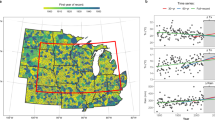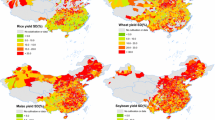Abstract
Long-term (approximately 80 years) daily climate records at 12 weather stations across the agricultural production region of the Canadian Prairies were assessed to evaluate trends in seasonal heat units and moisture characteristics for corn (Zea mays). Crop water demand (CWD) and crop water deficit were modelled at each station. Growing season accumulation of these as well as corn heat units (CHU) and rainfall were tested for long-term trends using linear regression. Significant positive trends in CHU were present in the southernmost stations while the northern stations displayed no trend or significant negative trends. Growing season precipitation showed a significant increase on average and most stations showed a positive trend but only one station showed a significant positive trend. CWD declined at most stations with significant negative trends at seven stations. Crop water deficient also declined with significant negative trends at six stations. The spatial variation in these results and those reported in other studies in the region underscores the difficulty involved in forecasting future trends in agroclimatic conditions.
Similar content being viewed by others
References
Akinremi O, McGinn S, Cutforth H (1999) Precipitation trends on the Canadian prairies. J Climate 12:2996–3003
Andresen J, Alagarswamy G, Rotz C, Ritchie J, LeBaron A (2001) Weather impacts on maize, soybean, and alfalfa production in the Great Lakes region. Agron J 93:1059–1070
Baier W (1971) Evaluation of latent evaporation estimates and their conversion to potential evaporation. Can J Plant Sci 51:255–266
Baier W, Robertson G (1965) Estimation of latent evaporation from simple weather observations. Can J Plant Sci 45:276–284
Bootsma A (2009) Decadel trends in crop heat units (CHU) in the Prairie provinces. Available via http://ca.geocities.com/bootsmaa/. Accessed 24 Feb 2009
Bootsma A, Tremblay G, Filion P (1999) Risk analysis of heat units available for corn and soybean production in Quebec. Tech Bull 991396, Agric and Agri-Food Canada
Brown D (1969) Heat units for corn in southern Ontario. Ontario Information Leaflet 111/31, Ontario Dept Agric and Food, Toronto
Centre for Land and Biological Resources Research (1996) Soil landscapes of Canada, vol 2.2. Research Branch, Agric and Agri-Food Canada, Ottawa. http://nlwis-snite1.agr.gc.ca/slc-ppc22/index.phtml. Accessed 14 Feb 2009
Cutforth H, O’Brien E, Tuchelt J, Rickwood R (2004) Long-term changes in the frost-free season on the Canadian prairies. Can J Plant Sci 84:1085–1091
Dai A, DelGenio A, Fung I (1997) Clouds, precipitation, and temperature range. Nature 386:665–666
DePauw R, Clarke J, McCaig T, Townley-Smith F (1998) Opportunities for the improvement of Western Canadian wheat protein concentration, grain yield and quality through plant breeding. In: Fowler D, Geddes W, Johnston A, Preston K (eds) Wheat protein production and marketing. University Extension Press, University of Saskatchewan, Saskatoon, pp 75–93
Easterling D, Horton B, Jones P, Peterson T, Karl T, Parker D, Salinger M, Razuvayev V, Plummer N, Jamason P, Folland C (1997) Maximum and minimum temperature trends for the globe. Science 277:364–367.
Hayter R (1978) Frost in northeast central Alberta. Essays on meteorology and climatology in honor of Richmond W Longley, KD Hage and ER Reinelt. Studies in Geography Monograph 3, Dept Geography, Univ of Alberta
Intergovernmental Panel on Climate Change (2007) Climate change 2007: the physical science basis. Fourth assessment report, Paris. http://www.ipcc.ch/. Accessed 14 Feb 2009
McGinn S, Shepherd A (2003) Impact of climate change scenarios on the agroclimate of the Canadian prairies. Can J Soil Sci 83:623–630
McGinn S, Touré A, Akinremi O, Major D, Barr A (1999) Agroclimatic and crop response to climate change in Alberta, Canada. Outlook Agric 28:19–28
Mekis E, Hogg W (1999) Rehabilitation and analysis of Canadian daily precipitation time series. Atmos Ocean 37:53–85
Nadler A (2007) An agroclimatic risk assessment of crop production on the Canadian prairies. MSc Dissertation, University of Manitoba. http://hdl.handle.net/1993/2829. Accessed 14 Feb 2009
Raddatz R (1989) An operational agrometeorological information system for the Canadian prairies. Climatol Bull 23:83–97
Raddatz R, Shaykewich C, Bullock P (1994) Prairie crop yield estimates from modelled phenological development and water use. Can J Plant Sci 74:429–436
Raddatz R, Ash G, Shaykewich C, Roberge K, Graham J (1996) First- and second-generation agrometeorological models for the prairies and simulated water-demand for potatoes. Can J Soil Sci 76:297–305
Roderick M, Farquhar G (2002) The cause of decreased pan evaporation over the past 50 years. Science 298:1410–1411
Skinner W, Gullet D (1993) Trends of daily maximum and minimum temperature in Canada during the past century. Climatol Bull 27:63–77
Soil Classification Working Group (1998) The Canadian system of soil classification. Agric Agri-Food Can Publ 1646:187
Tan C, Reynolds W (2003) Impacts of recent climate trends on agriculture in southwestern Ontario. Can Water Resour J 28:87–97
Timoney K (2009) Three centuries of change in the Peace—Athabasca Delta, Canada. Clim Change 93:485–515
Vincent L, Zhang X, Bonsal B, Hogg W (2002) Homogenization of daily temperatures over Canada. J Climate 15:1322–1334
Walker G (1989) Model for operational forecasting of western Canada wheat yield. Agric For Meteorol 44:339–351
Zhang T, Barry R, Knowles K, Heginbottom J, Brown J (1999) Statistics and characteristics of permafrost and ground-ice distribution in the northern hemisphere. Polar Geogr 2:132–154
Zhang X, Vincent L, Hogg W, Niitsoo A (2000) Temperature and precipitation trends in Canada during the 20th century. Atmos Ocean 38:395–429
Author information
Authors and Affiliations
Corresponding author
Rights and permissions
About this article
Cite this article
Nadler, A.J., Bullock, P.R. Long-term changes in heat and moisture related to corn production on the Canadian Prairies. Climatic Change 104, 339–352 (2011). https://doi.org/10.1007/s10584-010-9881-y
Received:
Accepted:
Published:
Issue Date:
DOI: https://doi.org/10.1007/s10584-010-9881-y




